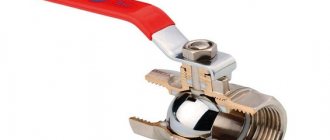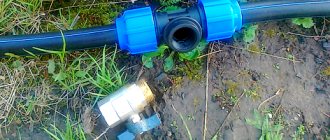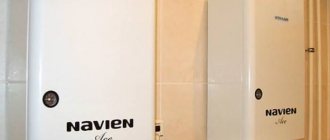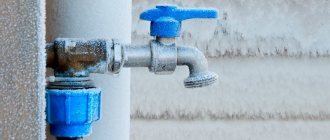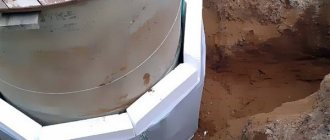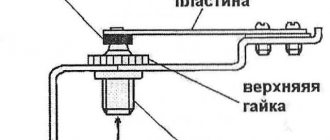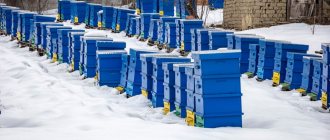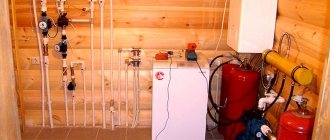Recommendations
When preparing water pipes for preservation, it is worth remembering that all work must be carried out at an outside air temperature of at least 5? C.
In order to properly drain water from water pipes, their design must include the following details:
- A valve and a drain tee must be installed on the pipe valve supplying well water or a well caisson.
- Water pipes must be made of low-density polyethylene or polypropylene. This will prevent them from being damaged during emergency defrosting.
- A water drain valve must be installed at the lowest point of the pipeline branch.
- If drain taps are not installed, you need to install a tee. A car compressor is connected to it. It is used to blow through pipes.
- If a water heater is connected, you need to install a tap and tee to drain the water. They must have a hose attachment to the check valve on the incoming water heating pipe. In addition, a tee with a tap must be installed on the outlet pipe from the water heater to quickly supply air when draining the water.
Advice! It is recommended to use classic ceramic faucets and taps with a rubber seal. They will not be damaged if residual water in the pipeline freezes.
Preservation of the summer cottage water supply system
Frosts can destroy pumping equipment, pipes, and household appliances if liquid is left in them for the winter, when the system is not insulated and the country house is not heated. Therefore, water is removed from wherever it might freeze. This is convenient to do if, during the construction of the water supply system, a liquid drainage system has been thought out.
To do this, install shut-off and control valves:
- On the water supply pipe to the house in front of the check valve there is a tee with a tap.
- On the internal wiring at the lowest points there are valves for draining.
- If the pipes are under flooring, install compressor adapters to vent the system.
- On the pipe leading to the boiler, in front of the check valve, there is a tee with a tap. The same fittings are mounted on the outlet hose.
- Do not use single-lever faucets, which burst in the cold if there is even a little liquid left in them. Install ceramic taps with rubber gaskets.
Such preliminary work, taken into account when designing the water supply system, makes it easier to drain water for the winter.
Draining water from your home plumbing
To drain water from the pipeline leading into the house, open the tap, which is located in front of the check valve. You can hear the bubbling of liquid and noise from escaping air bubbles. If there is no special valve, disconnect the pipes at the very bottom and drain the water.
They move on to the water heater, which is pre-cooled. If there are no drain taps, unscrew the safety valve and connect a piece of hose. The nut on the outlet pipe is released - air is sucked from the boiler, and water is drained through the connected hose. If the liquid is hot, do not pour it into the septic tank - the boiling water will kill the bacteria. A long hose is taken outside and discharged.
There is some water left in the washing machine. It is located in the hose that goes from the tank to the pump. They squeeze it and, using it like a pear, remove the residue, which goes into the drain hose. Turn the car over and place it on the roof. This will get rid of any liquid that remains in the unit. In this position it is left to spend the winter.
Drain the water from the shower. First, unscrew the watering can. Open the taps one by one. They use a compressor connected to a hose, an air pump, or blow air out of the lungs. The position of the valves is changed to drain the liquid from the supply hoses for cold and hot water.
They proceed to the toilet. Drain the water from the flush tank. Pump out the water seal completely using a pump, syringe, or sprayer. If odors leak from the septic tank, fill in with anti-freezing automotive fluid, a saturated saline solution. In the spring it is removed without washing it into a septic tank - it is detrimental to the microflora.
Plumbing diagram for a dacha.
Unwind all the siphons and remove any remaining liquid in the glasses. Remove the filters and pour out the water. Do not forget about the drain if it is used in the shower stall for water drainage.
What remained was the pumping station, which had previously been disconnected from the network. Unscrew the cap and pour the water into the prepared container. It is advisable to blow with compressed air so that any remaining liquid leaves the hydraulic tank. If water remains in it, freezing damages the rubber membrane.
If the internal distribution pipes are located strictly horizontally, the water will not completely leave them by gravity. Blowing with a compressor is required.
Conservation of street water supply
At the dacha, they often use summer water supply for watering, outdoor showers, and car washing. Pipes laid on the surface are the first to suffer from frost. If there is a drain valve in front of the check valve, open it. Then the pump can be left in the source for the winter - it will not freeze. When there is no drain valve, pull out the pump and disconnect it from the water supply hose. When water is drained from the system, all water taps are opened.
Empty the storage tank and the container for the summer shower. Remove the watering can from it, open the tap, remove the remaining liquid.
For drainage to be effective, the pipes must be placed on a slope. Then the water will not linger in some place. Even a small amount of it, when frozen, can break the seal. If there is no required slope, connect the compressor and blow out the pipes with compressed air. Such an operation will not interfere, even if a drain valve is installed on the main line at the end point.
Conservation of street water supply.
The summer water supply hoses are wound up, freed from water, and put away for winter storage. Pipes dug shallow into the ground are blown out. Fittings exposed to the surface are removed, dried, and stored indoors until spring. If the water valves are not removed, they are left open. Ball valves especially suffer from frost. For the winter they are left half-open outside.
Plastic pipelines are not as susceptible to freezing as steel ones, but their threaded fittings suffer. Therefore, it is better to use welded joints. Polypropylene pipes are not destroyed by freezing. They are used if it is not possible to blow out the water supply with a compressor for preservation.
Stages of draining water from a pipeline
To drain water from the heating system, you need to do the following:
- Turning off the heating boiler or closing the distribution valve on the pipe extending from the riser.
- Shutting off the valve that collects water into the heating system.
- A hose must be attached to the drain valve of the radiator system. Here you need to correctly calculate its length. It must be sufficient to drain water into the street or into a sewer well.
- The drain valve on the heating radiator must be opened.
- On the heating system, you need to open the valves with air valves. This will ensure a faster drainage rate.
- Leaks may appear during the draining procedure. In order to avoid unpleasant incidents, you need to place a deep container in advance and place it under the drain hose and tap connection.
- At the end of the draining procedure, you need to disconnect the hose and drain the remaining water in it into a container.
Organization of winter water supply
Installation of a water supply system takes place in several stages:
- Preparatory.
- Installation.
- Check.
We insulate the water supply pump
The water supply system completely needs insulation, including the pump.
The material for insulating equipment is the same as for insulating a water supply branch:
- Extruded polystyrene foam.
- Styrofoam.
- Mineral wool.
Equipment does not need to be insulated if it is located below the freezing depth. The junction of water pipes and the pump must also be insulated. The junction point is called the pit. The pit is to be lined with brick, and the floor is covered with a concrete screed.
We thermally insulate the hydraulic accumulator
A hydraulic accumulator is a storage tank that operates under pressure; the container must be leak-tight. The inner shell of the hydraulic accumulator is an elastic membrane, a vulnerable element of the hydraulic system that cannot withstand sub-zero temperatures. The hydraulic system is covered with insulating material.
Thermal insulation of a hydraulic accumulator with your own hands.
Types of insulation for hydraulic accumulators:
- Extruded polystyrene foam.
- Styrofoam.
- Mineral wool.
- Basalt wool.
- Fine cell insulation.
Install the drain valve and pressure switch
The conservation system involves installing a drain valve. The ability to drain water from the supply system will preserve the water supply if there is a need for a long absence in the winter.
A pressure switch is an element of the water supply system that regulates the uninterrupted operation of the hydraulic system. After the structure is completely filled with water, the relay automatically turns off the pump until the next use.
We drain water from the central and autonomous water supply
In modern summer cottages, many people install a pipeline system. The pipeline may be connected:
- to the central water supply,
- to an autonomous water supply system.
If you need to drain water from the central pipeline during the winter, you need to do the following:
- Shutting off the water supply to the room. To do this, close the tap located on the inlet pipe.
- Opening all pipeline taps to drain water.
In order to drain water from the pipes at the dacha for the winter from an autonomous pipeline system, you need to do the following:
- If the water supply is from a well, the pump must be removed from it.
- It should be preserved for the cold period in accordance with the operating instructions.
- If you are using a container with a storage system, you need to open the drain valve on it.
- In places where water is consumed, also open the taps to empty the pipeline system.
- To completely remove water from the pipeline, you need to additionally blow it out using a compressor.
- If the storage tank is not used, you need to turn off all the taps on the pipeline system and drain the water.
How to mothball a well
The well is preserved for the winter so that in the spring it is completely ready for use. This means that throughout the winter we will not be able to use it; access to water will be completely blocked. We have already done the main work: we drained the water from the pipeline, heater and plumbing fixtures, and removed the pump.
Now the well is not in danger, the main thing is to close the wellhead correctly: screw on the head, which will protect sheets, etc. from rain, snow, and seal it tightly with film.
In a water supply system arranged according to all the rules, a caisson is made - it deepens the well below the freezing point, protecting it from rain and groundwater. A well with a caisson will survive any frost, the only thing is that this device is not cheap.
A FORUMHOUSE user with the nickname Lesha-Samurai has a fairly standard situation: there is a well 75 meters deep (self-flowing 10-15 m3 per hour), which will not be used in winter, and a categorical reluctance to install an expensive caisson.
According to FORUMHOUSE administrator Andrey 203, a caisson is the only reliable option in a leshy case.
A caisson is needed to move the wellhead below the freezing depth of the soil.
However, a successful method of caisson-free well conservation has yet been found. Using this technology, Lesha-Samurai and his friend have been preparing their well for winter for several years now.
- Take 6-7 soda bottles (there should be some drink left in each bottle), shake each bottle to create pressure in them.
- Remove the head of the well and insert bottles into it.
- Put the head back.
- Pump air into the well using a car compressor through the nipple (pump for about 10 minutes). This will ensure that the water level in the well is reduced to the level of soil freezing.
- Shut off the air outlet from the well with a ball valve.
You can take a plug for 1, use a drill to make a hole of a suitable diameter in it and insert a nipple into it with oil.
Even if air leaves the well through elements of such a structure and the water level rises, the bottles will prevent its expansion.
Compressors and their variants
In order to blow out country pipes, you will need special equipment of varying power. It all depends on the complexity of the pipeline and its length.
Let us consider in more detail the possible options for this equipment, which differ in individual characteristics.
Piston compressor
Here, air is compressed in piston cylinders according to the operating principle of an internal combustion engine. The advantage of this type is the simplicity of the design, its maintainability and low cost. The disadvantage is the limited operating time and noise of this process.
Scroll compressor
This type is distinguished by its small dimensions and low productivity. Its work occurs as a result of the interaction of two helices. Such equipment is suitable for blowing short-length pipes with small diameters.
Screw compressor
The operating principle of such a device is based on the parallel rotation of two special screws. Due to low friction, this process requires little electricity and is characterized by low noise.
On the other hand, it should be noted the high productivity of this design. He is able to create sufficient pressure. Due to the complexity of the design, such products are very expensive and difficult to repair.
Diaphragm compressor
This type is similar to the piston design. A membrane is used instead of a piston. Its features are low efficiency and low pressure. To increase power, a small receiver is used in which compressed air is stored.
As a result of the combined work of these two elements, low-power equipment is capable of creating high pressure. This way you can significantly save your family budget. After all, to purify the water supply of a private house or cottage, there is no need to buy powerful equipment.
Be careful with the pressure you use.
Making your own compressor
The canister is equipped with a bicycle nipple and a water hose that has a fitting. One of the taps, which has a male thread, is connected to the female fitting. In this case, the foot pump is snapped onto the nipple. After turning off the main main tap, be sure to open all the taps to spontaneously remove some of the water. At the end, all taps are closed (titanium shut-off, as well as taps in the house and summer kitchen, outdoor tap for watering). Then the pump and receiver are connected to a street tap and pumped, followed by opening the adjacent tap to completely eliminate any remaining water.
Then the water supply network is filled again, the common tap is closed and similar actions are performed with the remaining taps open. The result is identical to the above.
In general, such a receiver is suitable for removing residual water from a water supply system even if the water supply system is not disassembled.
